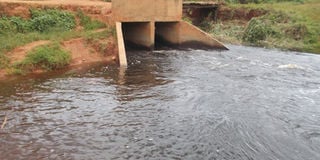Bridge money splits Kyegegwa leaders

Kafuro Bridge that connects Kakabara and Hapuyo sub-counties in Kyegegwa District. PHOTO BY ALINAITWE TIBENDA
What you need to know:
Residents say their businesses are paralysed and children cannot access schools due to the poor state of the bridge.
KYEGEGWA. The Kyaka North Member Parliament, Mr Paul Asaba, and the Kyegegwa District chairman, Mr John Byamukama Kisoke, have clashed over Shs117 million meant to construct Kafuro Bridge in Kigambo village.
The bridge connects Kakabara and Hapuyo sub-counties in Kyegegwa District.
Mr Asaba on Wednesday said last week residents demonstrated over the same issue because Mr Kisoke had not fulfilled his promise of fixing the bridge before October.
Residents claimed that their businesses have been paralysed and their children’s right to education is being deprived as they can nolonger access schools.
They appealed to the government to come to their rescue.
Mr Asaba told journalists that he last year brought the matter to the minister of Disaster Preparedness, Mr Musa Ecweru, who promised to contact relevant authorities, including Parliament.
He said government released Shs120 million to the district to fix the bridge under the Uganda Road Fund.
“I am surprised that up to now this bridge has not yet been fixed. We had agreed with the district planning committee on how to use it,” Mr Asaba alleged. The area LC 3 chairman, Mr Sam Kwetonda, said for the last four years various politicians have been promising to work on the bridge in vain.
Mr Kwetonda said the residents with assistance of Mr Asaba have set up a temporary bridge to enable children access schools.
When contacted, Mr Byamukama said: “What I know is Kyegegwa District council approved Shs117 million in this financial year’s budget. The Uganda road fund also approved it, so in the third quarter we received Shs17 million. We have now advertised for a company to do the design. We are expecting more Shs100 million and construction will begin in January 2019 when the water levels go down.”
According to the 2015 National Service Delivery Survey constraints faced in the maintenance and repair of roads include inadequate funding (66 per cent), inadequate equipment (54 per cent) and delayed remittance of funds (37 per cent).
While conflict (11 per cent), corruption (8 per cent) and insecurity (3 per cent) were considered as minor challenges.


